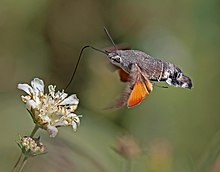| Hummingbird hawk-moth | |
|---|---|

| |
| In flight | |

| |
| At rest | |
| Scientific classification | |
| Domain: | Eukaryota |
| Kingdom: | Animalia |
| Phylum: | Arthropoda |
| Class: | Insecta |
| Order: | Lepidoptera |
| Family: | Sphingidae |
| Genus: | Macroglossum |
| Species: | M. stellatarum
|
| Binomial name | |
| Macroglossum stellatarum | |
| Synonyms | |
| |

The hummingbird hawk-moth (Macroglossum stellatarum) is a species of hawk moth found across temperate regions of Eurasia. The species is named for its similarity to hummingbirds, as they feed on the nectar of tube-shaped flowers using their long proboscis while hovering in the air; this resemblance is an example of convergent evolution.
The hummingbird hawk-moth was first described by Carl Linnaeus in his 1758 10th edition of Systema Naturae. As of 2018, its entire genome and mitogenome have been sequenced.[1]
- ^ Li, Jun; Zhang, Yaoyao; Hu, Kunjie; Zhao, Yaqi; Lin, Ruirui; Li, Yan; Huang, Zhuoran; Zhang, Xu; Geng, Xuexia (2018-07-01). "Mitochondrial genome characteristics of two Sphingidae insects (Psilogramma increta and Macroglossum stellatarum) and implications for their phylogeny". International Journal of Biological Macromolecules. 113: 592–600. doi:10.1016/j.ijbiomac.2018.02.159. ISSN 0141-8130. PMID 29501752. S2CID 3983266.